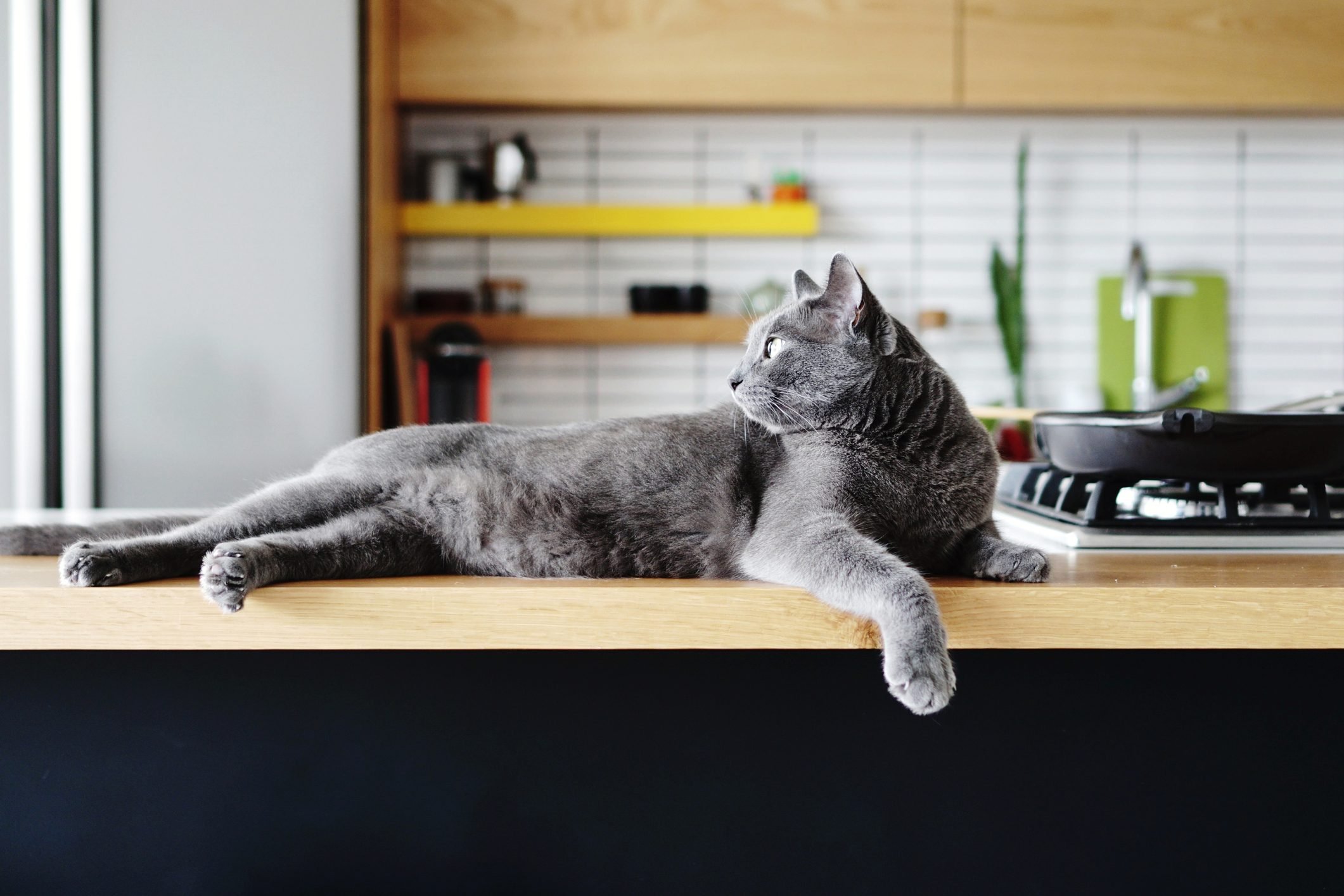
Dogs and cats in the kitchen
With their easy-to-clean flooring, allowing your dog or cat free reign of the kitchen may seem like a no brainer; after all, if they do make a mess, it’s easy to wipe it up. While that logic follows, it’s important to know that there are a lot of potential dangers for your four-legged friends lurking in your kitchen. Here, veterinarians and other pet experts point out the potential hazards and the best pet-proofing solutions. While you’re at it, find out the top 30 things your dog wishes you knew.

Store human foods out of your pet’s reach
$39.97
Even the most seasoned pet owners might not realize there are a number of foods that, while perfectly harmless to humans, can put a pet in grave danger, Jamie Richardson, DVM, Medical Chief of Staff at the Small Door Veterinary practice, tells Reader’s Digest. Top food dangers include chocolate (and anything flavored with real chocolate, including chocolate chip cookies, chocolate frosting, chocolate sauce, etc.), grapes, raisins (tiny as these are, a single raisin can send your dog to the hospital with kidney damage and other health issues), and these other common foods that could be toxic for dogs.
But being aware of the danger isn’t enough, points out Kait Hembree, head of training at GoodPup, a virtual dog training service. Dogs and cats are all too good at jumping on counters, so you also need to be careful about how you store your food. Keep potentially toxic foods well out of their reach and in airtight storage containers, like this Chef’s Path 7-piece food storage container set, that even the craftiest dog or cat won’t be able to open.
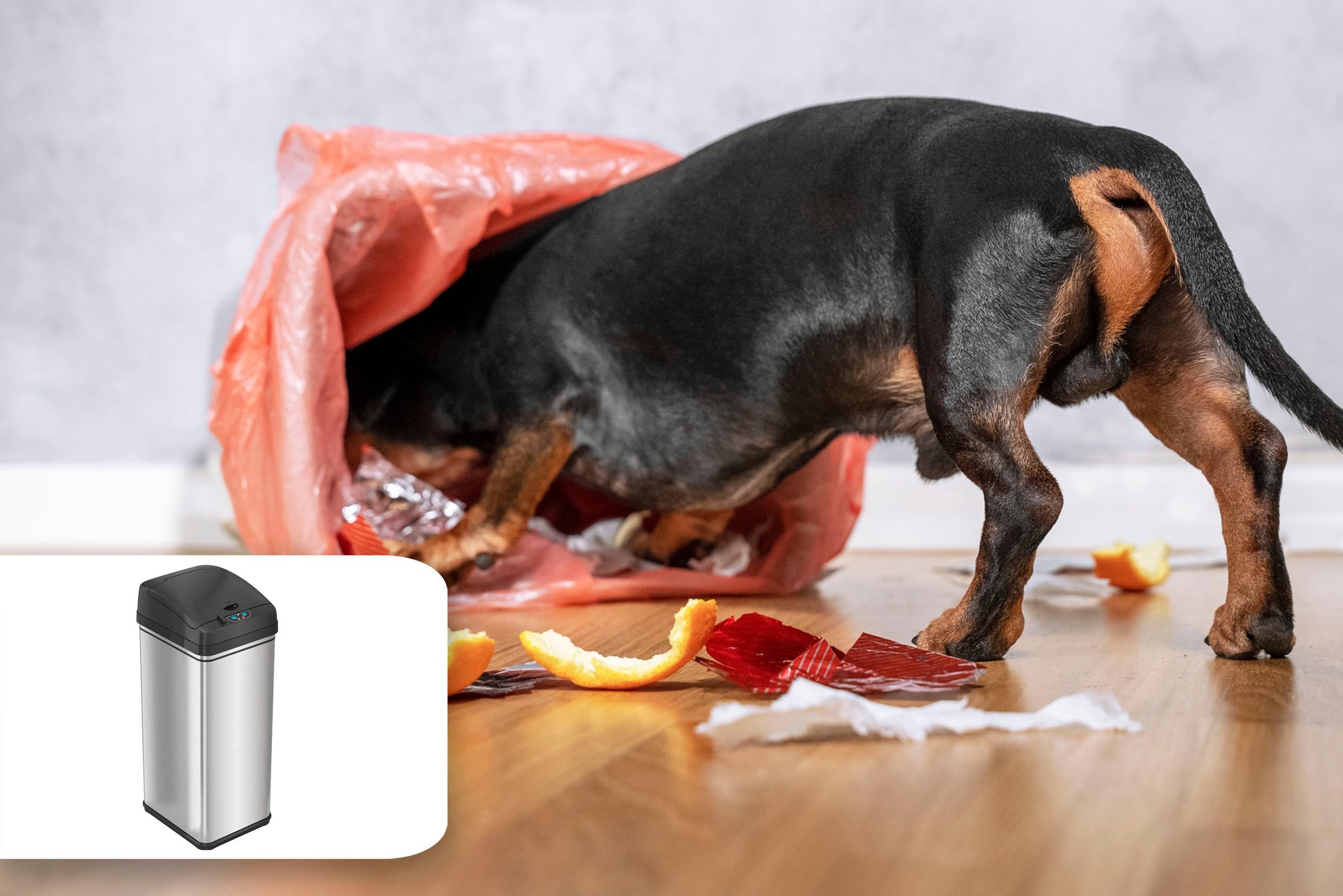
Lock up garbage and compost
$69.50
Any food that poses a danger for pets continues to do so even after being tossed in the trash, and perhaps even more so if it becomes moldy. That’s because mold contains tremorgenic mycotoxins, which can be highly toxic to animals at very small doses, explains Madison Rose, DVM, who works with Peaceful Waters Aquamotion, a pet cremation alternative. Since some pets, especially dogs, will rummage in the garbage any chance they get, it’s worth investing in a garbage can that prevents pets from knocking over and looting, such as this one from iTouchless. On the other hand, these human foods are actually good for your pup.
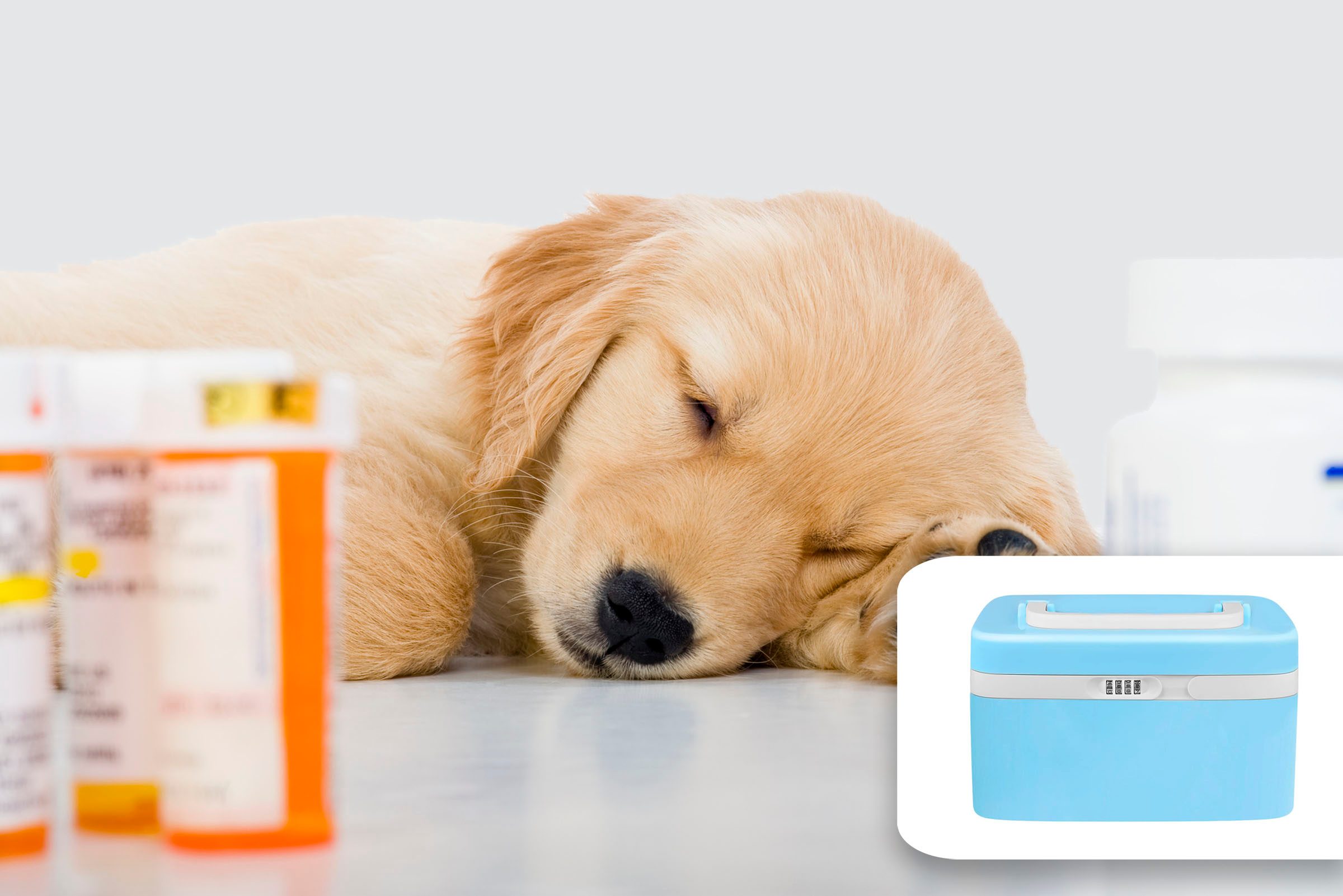
Lock away human medications…
$30.99
Some of the most commonly ingested human medications can be toxic to animals, causing anything from gastrointestinal upset to kidney and liver failure, Caroline Wilde, staff veterinarian at Trupanion tells Reader’s Digest. These include over-the-counter painkillers (including ibuprofen and Tylenol), nutritional supplements, and prescription medications such as heart and blood pressure medications, amphetamines, antidepressants, decongestants, and birth control pills. So it’s important to keep your medications away from your pets by keeping all your medications and supplements in a locked portable “medicine cabinet” such as this one from eoere and, should you spill any liquid medication, clean it up quickly before they can lick it. Puppy in pain? Find out what you can give a dog for pain.
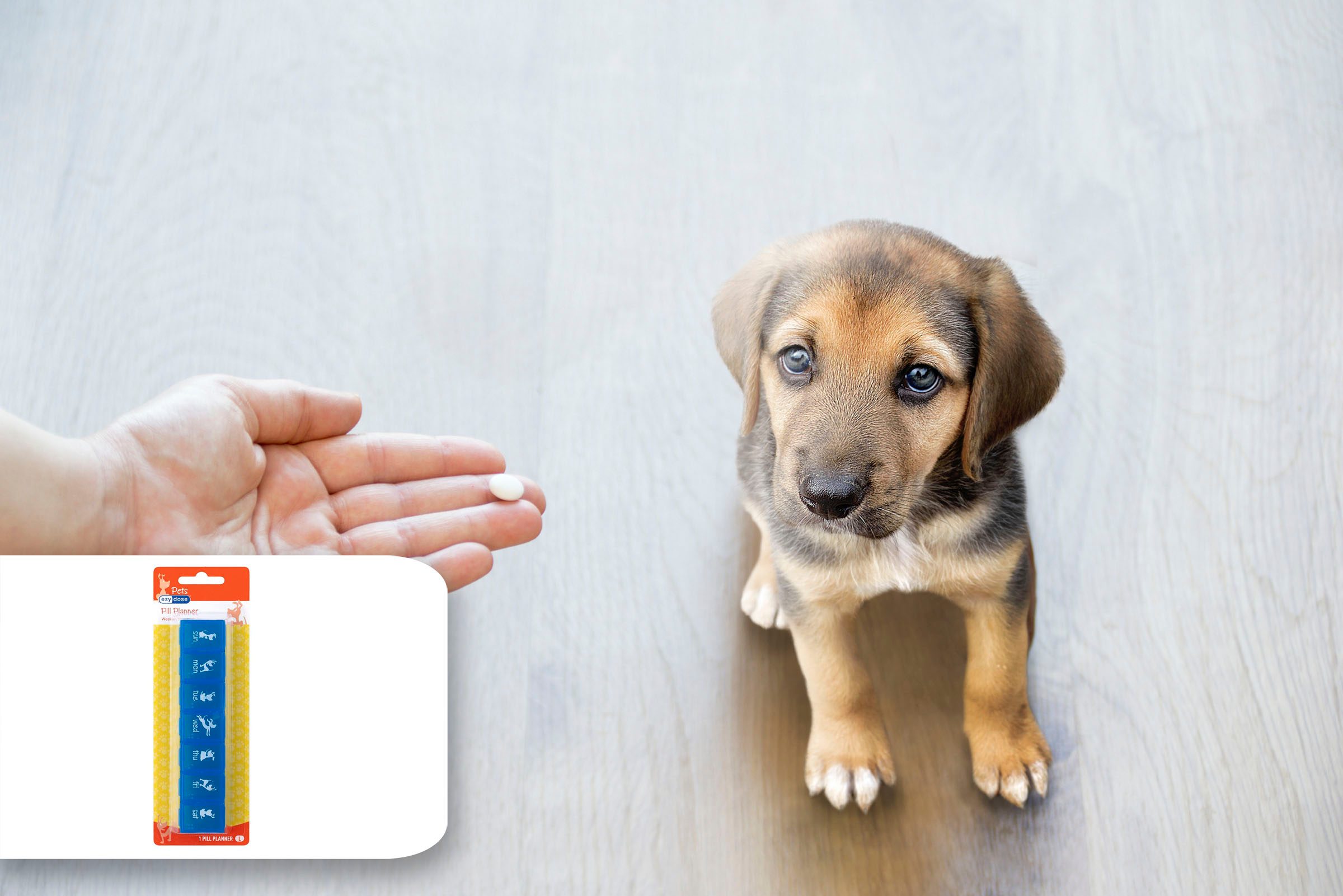
…ditto with pet medications
$5.49
Pets can overdose on their own medication, points out Dr. Richardson, and it’s more of a risk than you might think because some pet medications are available in pet-friendly “flavors.” So, if your dog has been prescribed medication, please treat it as you would your own medications, as discussed above. To keep your pet meds from getting mixed up with your own, you can keep them in child-proof pill organizers such as this adorable one from EZY Dose that has little doggies printed on it, just to be sure. Find out the 17 things your cat would love to tell you.
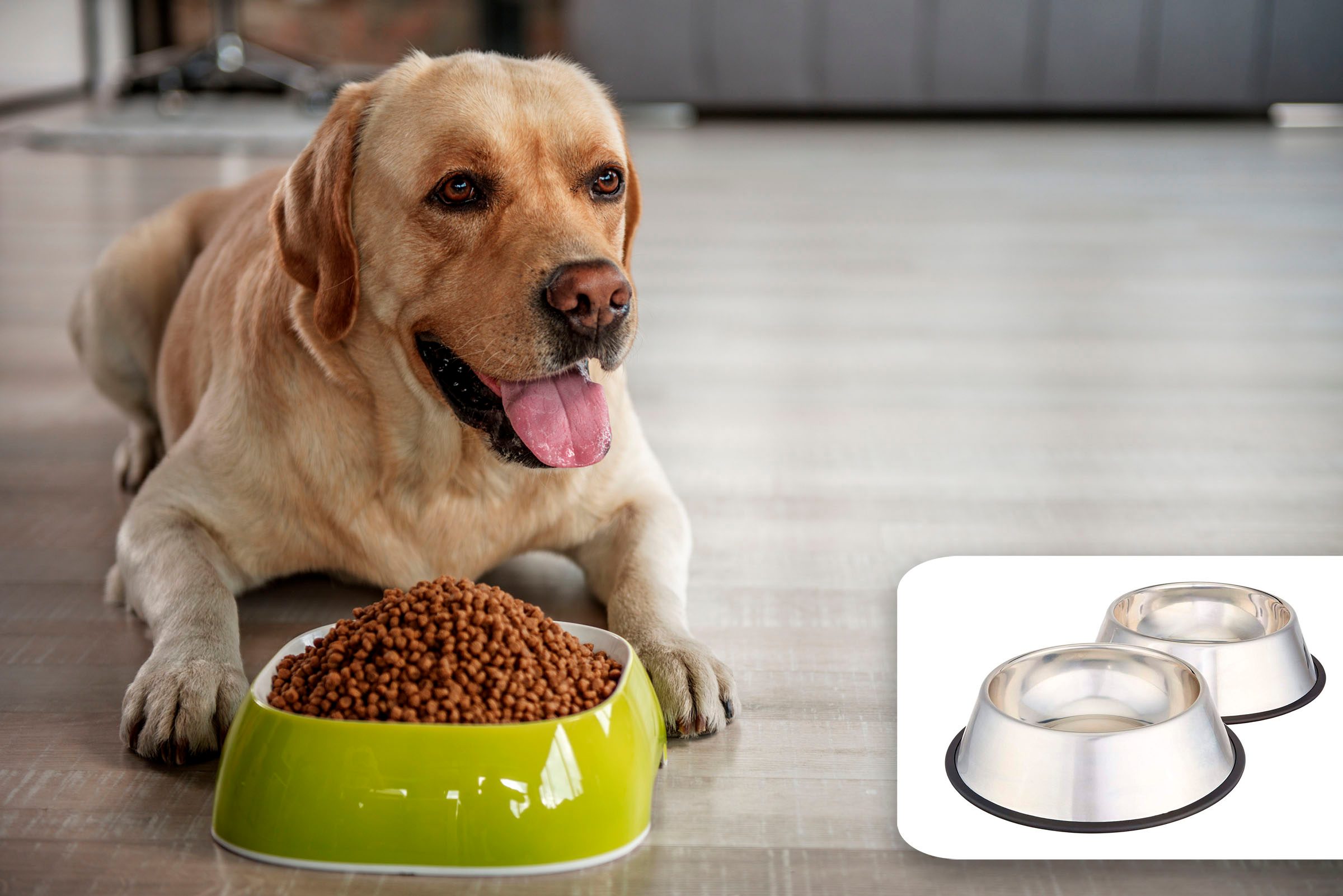
Prevent your pup from eating too much
$13.99
If your pet is overweight or headed in that direction, you’ll want to take action sooner rather than later because obesity in pets presents a wide variety of health consequences. One way to help your pet lose weight is to mind how much food you give them during the day. Of course, for a lot of animals, especially dogs in the hound family, too much food is never enough. So if your fur baby scarfs down whatever’s in their bowl and then looks at you with puppy-dog eyes, you might want to consider this slow feeder from Jasgood. Its unique design makes whatever you’re feeding Fido take longer to eat, which can help provide a feeling of satiety. And make sure to look into these no-spill water bowls designed for dogs with drinking problems.
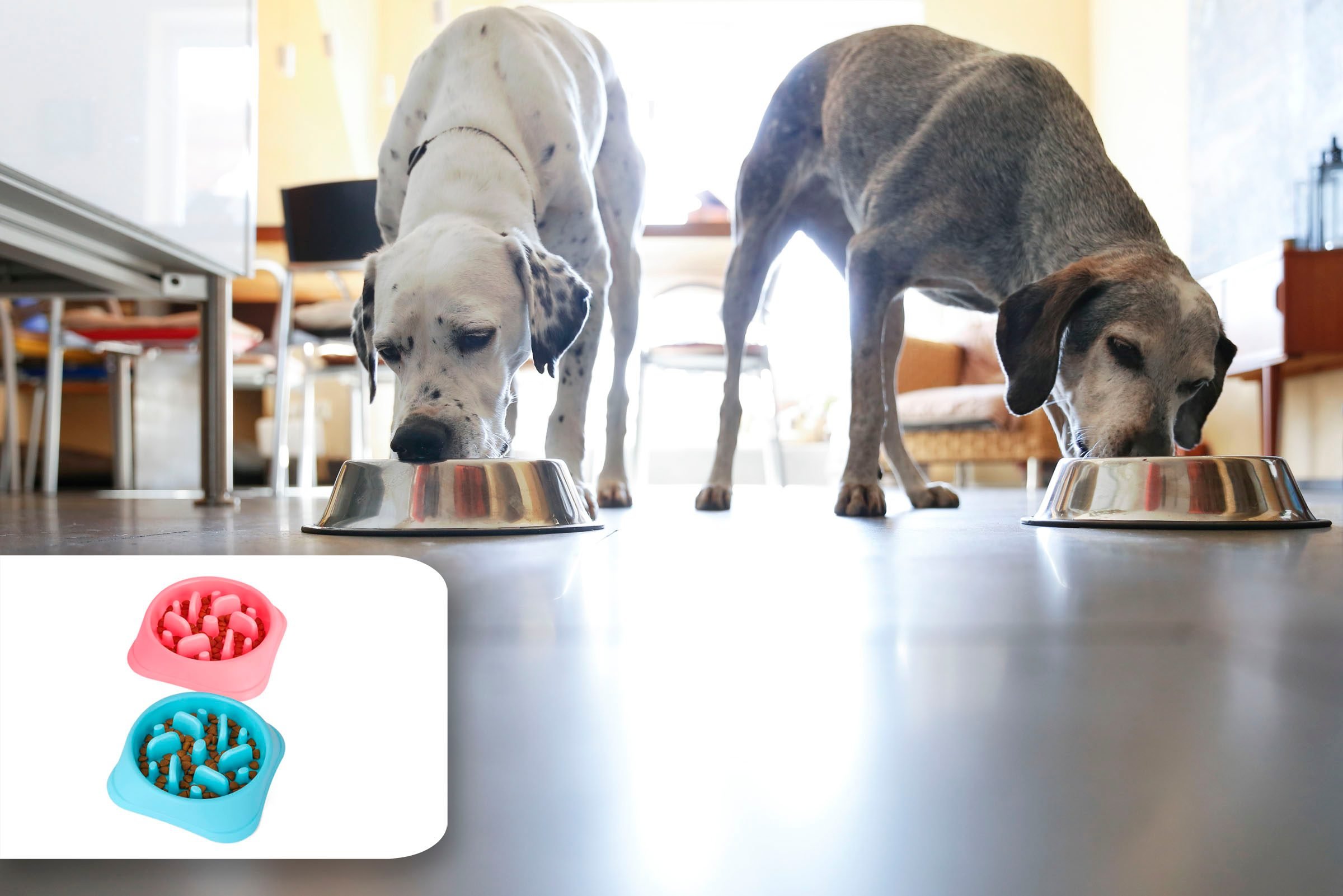
Wash their dishes regularly
$17.99
“Many pet owners keep their pet’s food and water bowls in the kitchen because it’s practical,” observes Matt Clayton, founder of PetHairPatrol.com, but what most don’t realize is that those bowls can be one of the germiest things in your home, let alone your kitchen. “The slimy biofilm that forms on the surface may contain bacteria like E. coli, MRSA, listeria, salmonella, and even mold and yeast,” he says, all of which can pose a health risk to your pet—and you. Although a quick rinse with soap and water is helpful, it’s better to disinfect their bowls in your dishwasher using the hot wash cycle at least once per week. In addition, Dr. Richardson notes that plastic dishes can get much germier, much faster than ceramic and stainless steel bowls.
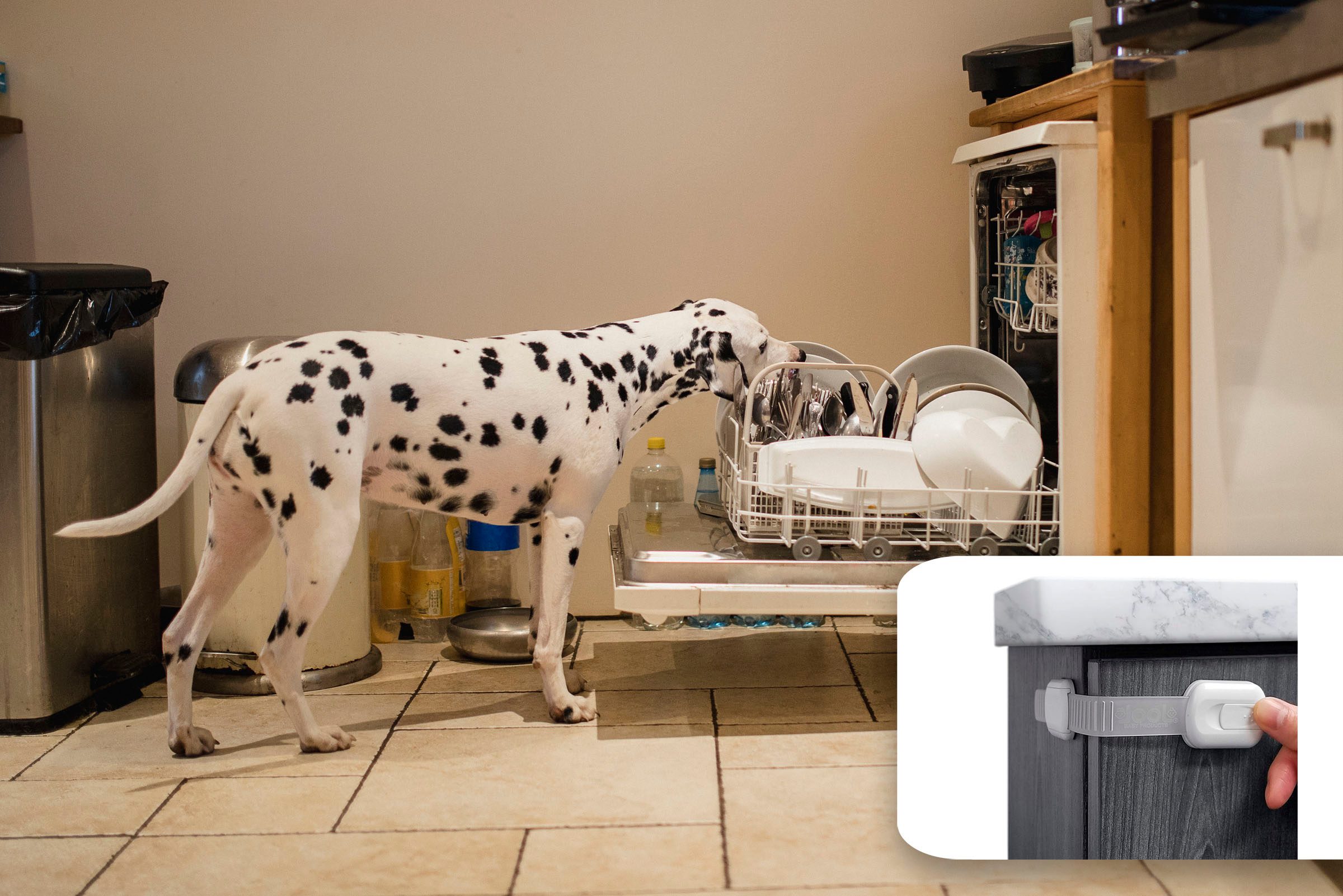
Close your dishwasher
$9.95
Your dishwasher is great for disinfecting your pet’s dishes, but please be careful about leaving it open, especially when it’s loaded, according to Steffi Trott, the owner and founder of SpiritDog Training, an online dog training resource. “It’s just too tempting to your dog, who is eager to lick anything that smells good but who can’t distinguish between spoons and knives,” she explains. The result can be a bad cut or even a severed tongue. This Jool Baby Products safety strap is easy to install and will hold your dishwasher closed.
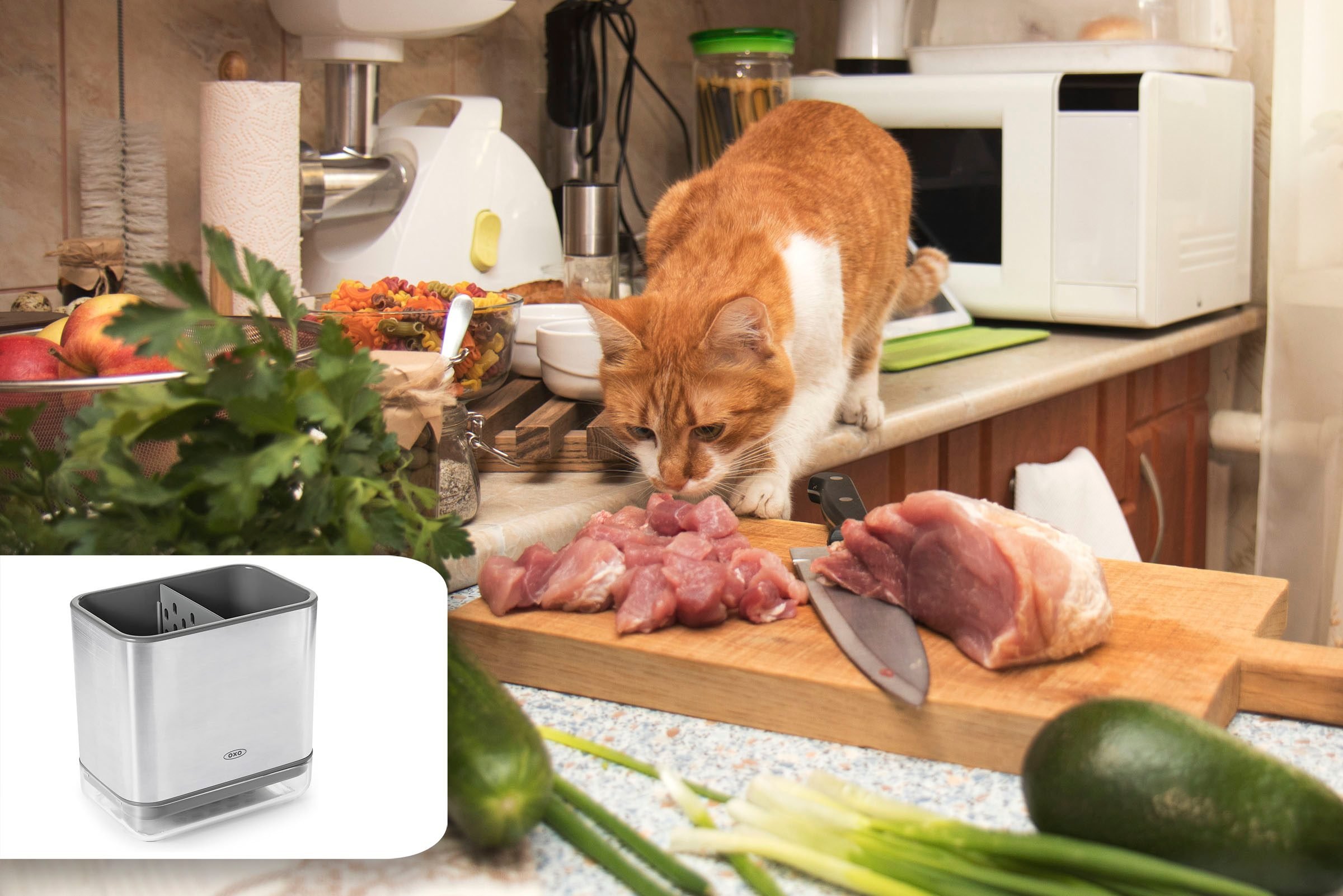
Keep knives, skewers, and other sharp utensils away from your pet
$19.99
Knives are far from the only sharp utensil that can attract your dog or cat’s attention when coated with good-smelling food. While it goes without saying that if you drop a sharp knife on the floor, you should pick it up (and wash it) immediately, it’s also worth noting that you should never leave sharp items unattended on your countertop while cooking, advises Colby Lehew, head of dog training at Chicago’s Dogletics. Consider keeping a sinkware caddy, like this one from OXO, on your counter to safely hold utensils you’re in the middle of using. Here’s why your dog always brings their bones elsewhere to eat.

Protect ovens and stovetops
$21.80
Cats that have a tendency to jump on counters (and what cat doesn’t?), as well as certain dogs, are in serious danger of getting burnt by hot stovetops. The risk is even greater with electric stovetops, which can remain hot even after you’ve turned it off and walked away. Providing a barrier, such as in the form of a stove guard, can help prevent injuries, says Lehew. However, It’s not just your kitchen you need to be careful about; these other household items could also have the potential to serious hazards for your pet.
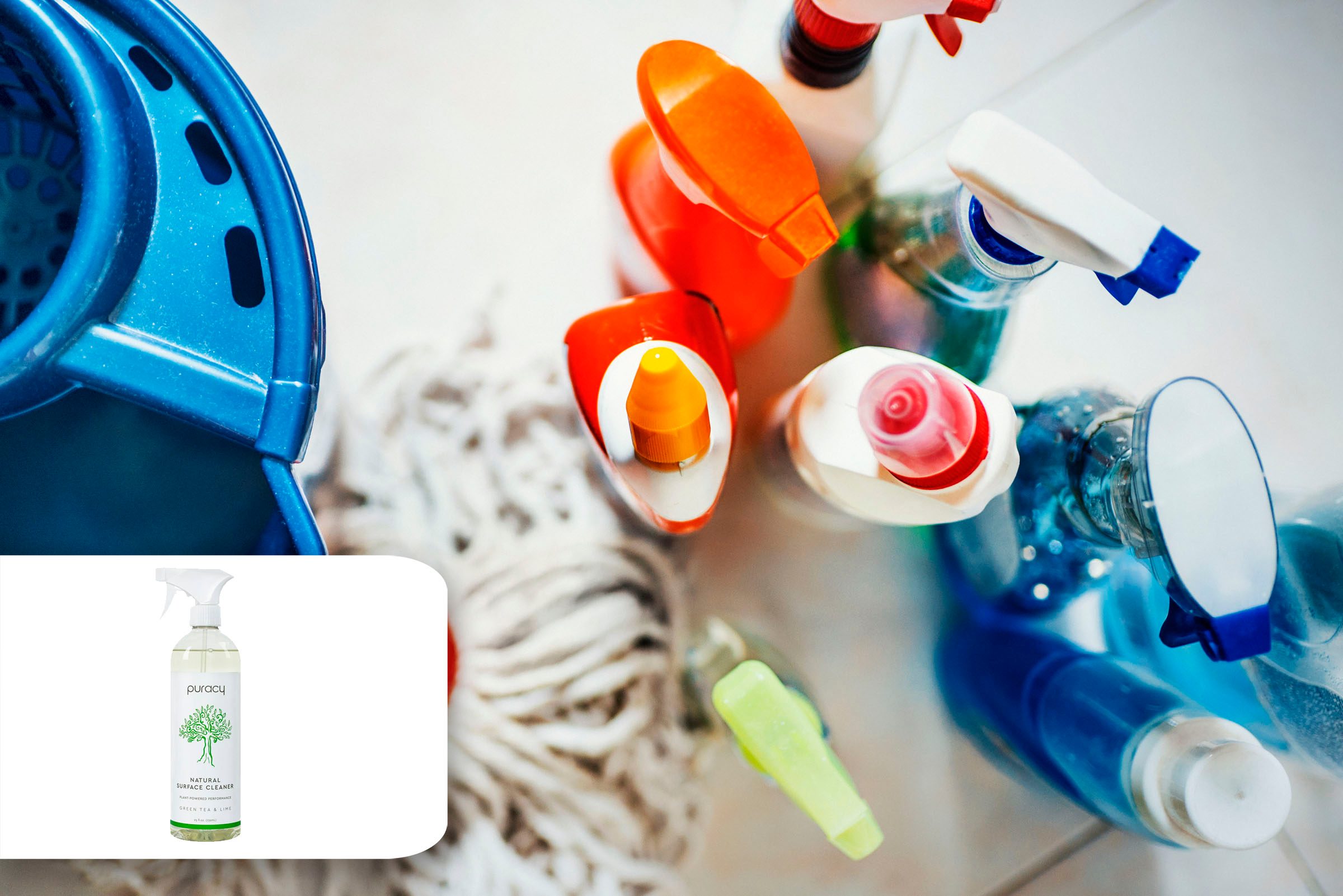
Invest in a child lock for cleaning products and detergents
$6.99
Many household cleaners can be toxic or corrosive to the esophagus and stomach, including Lysol products, oven cleaner, hand sanitizer, and bleach, according to Dr. Richardson, who advises locking the cabinet doors where you store your cleaning products. This Adoric U-shaped lock works for cabinets with double doors. Another option is replacing your chemical cleaning products with non-toxic products, because even if the cleaner is locked away, there’s still a chance your pet could be exposed to them by, say, licking their paws after they walked over a freshly mopped floor. Puracy Natural All-Purpose Surace Cleaner is a top-rated pet-friendly option.

Safely store CBD products
Pet owners in states where CBD is legal should be aware of the importance of keeping it safe from Doggo, who can become sick from consuming it, especially in the form of edibles, points out Dr. Richardson. This SafeLocker is smell-proof and impossible for your pooch to open. Here is what the experts are saying about the safety of CBD oil for dogs.
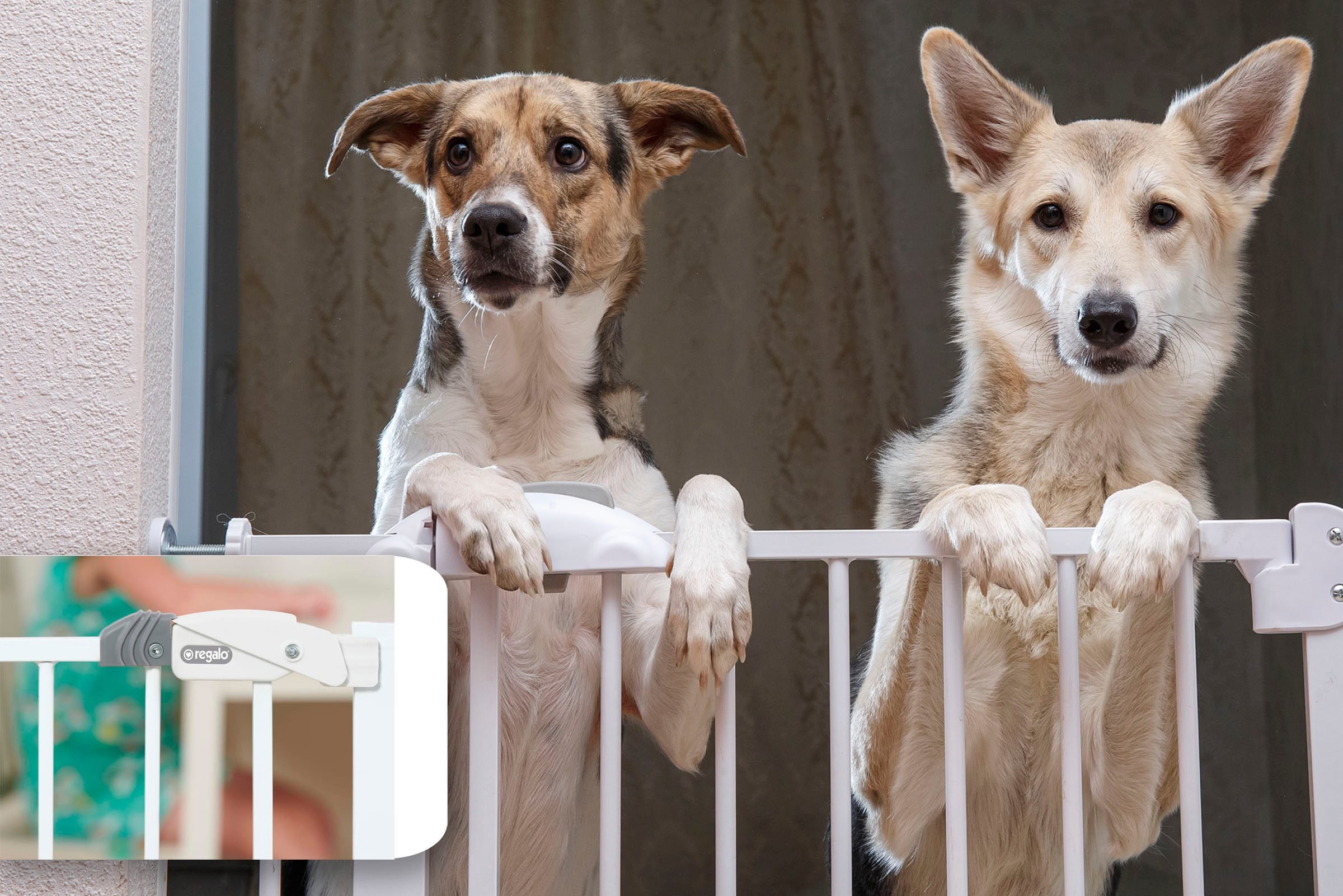
Reconsider pesticides
$38.99
Pesticides are as dangerous—and often as appealing—for pets as they are for pests. So, it’s important to keep them locked away, just as you would toxic cleaners. Another option, suggests small animal and exotic veterinarian, Sarah Ochoa, DVM, is to keep your kitchen off-limits to your pets by closing off the entryways with a baby gate such as one from this Regalo, which is an Amazon’s Choice product. Or consider one of these chemical-free ways to get rid of household pests.

Remember: crates help keep dogs safe
$28.99
One virtually foolproof way of keeping your dog safe when you’re busy prepping dinner or aren’t at home is to crate train your pup, notes Ryan Rucker, DVM, a veterinarian and spokesperson for Zesty Paws nutritionally supplemented treats. Find out the crate-training tips every dog owner must know.
Sources:
- Jamie Richardson, DVM, Medical Chief of Staff at the Small Door Veterinary
- Kait Hembree, head of training at GoodPup
- Matt Clayton, founder of PetHairPatrol
